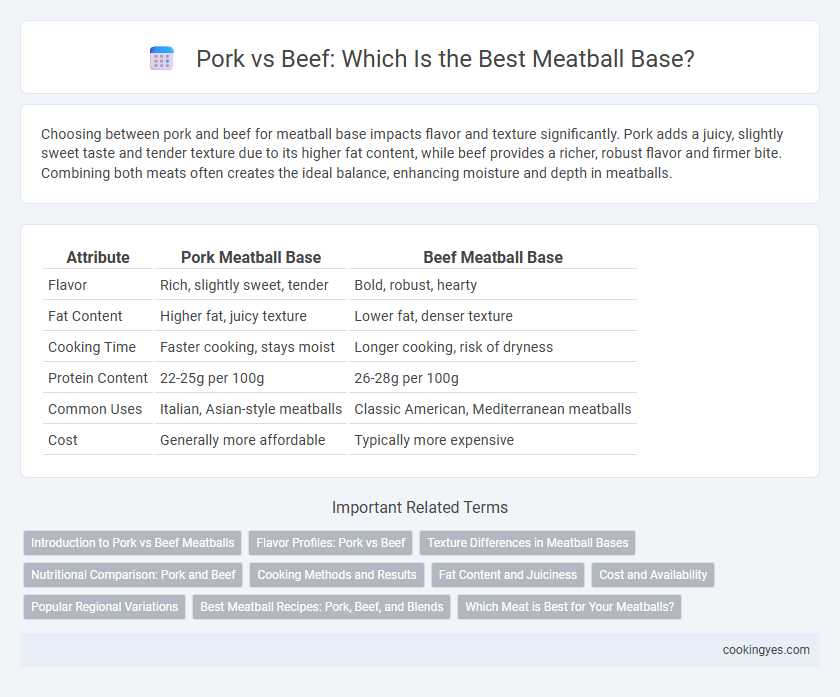Choosing between pork and beef for meatball base impacts flavor and texture significantly. Pork adds a juicy, slightly sweet taste and tender texture due to its higher fat content, while beef provides a richer, robust flavor and firmer bite. Combining both meats often creates the ideal balance, enhancing moisture and depth in meatballs.
Table of Comparison
| Attribute | Pork Meatball Base | Beef Meatball Base |
|---|---|---|
| Flavor | Rich, slightly sweet, tender | Bold, robust, hearty |
| Fat Content | Higher fat, juicy texture | Lower fat, denser texture |
| Cooking Time | Faster cooking, stays moist | Longer cooking, risk of dryness |
| Protein Content | 22-25g per 100g | 26-28g per 100g |
| Common Uses | Italian, Asian-style meatballs | Classic American, Mediterranean meatballs |
| Cost | Generally more affordable | Typically more expensive |
Introduction to Pork vs Beef Meatballs
Pork meatballs offer a tender texture and rich flavor due to higher fat content, making them ideal for moist, juicy meatballs. Beef meatballs provide a heartier, robust taste with a firmer bite, often preferred for classic Italian recipes. Choosing between pork and beef bases depends on desired flavor profiles and moisture levels in the final dish.
Flavor Profiles: Pork vs Beef
Pork offers a sweeter, milder flavor with a tender, juicy texture that enhances the meatball's richness, while beef provides a deeper, more robust taste with a slightly firmer bite, adding a savory intensity. Combining pork and beef creates a balanced blend, merging pork's subtle sweetness and moisture with beef's hearty, umami depth. Choosing pork emphasizes softness and subtlety, whereas beef highlights boldness and a rich, meaty aroma in meatball flavor profiles.
Texture Differences in Meatball Bases
Pork meatballs typically offer a tender and juicy texture due to higher fat content, which helps retain moisture during cooking. Beef meatballs usually have a firmer, denser texture, contributing to a heartier bite but potentially drier consistency if lean cuts are used. Combining pork and beef balances tenderness and firmness, creating a meatball with optimal texture and flavor.
Nutritional Comparison: Pork and Beef
Pork meatballs offer higher vitamin B1 (thiamine) content, essential for energy metabolism, while beef provides more iron and zinc, supporting immune function and oxygen transport. Beef meatballs typically have a higher saturated fat content, contributing to increased calorie density compared to pork. Choosing between pork and beef as a meatball base depends on nutritional priorities such as vitamin intake versus mineral content and fat composition.
Cooking Methods and Results
Pork meatballs tend to remain juicier and more tender due to the higher fat content, especially when baked or pan-fried, which helps retain moisture and enhances flavor. Beef meatballs, often leaner, benefit from slow simmering or braising, allowing the meat to soften and absorb surrounding sauces for a richer taste. Combining both meats can optimize texture and flavor, balancing pork's succulence with beef's robust taste during various cooking methods.
Fat Content and Juiciness
Pork meatballs typically contain higher fat content than beef, resulting in a juicier and more tender texture. Beef offers a leaner profile, often requiring added fat or moisture to achieve comparable succulence. Balancing fat percentages is crucial for meatball flavor, with pork providing natural juiciness while beef delivers a robust, beefy taste.
Cost and Availability
Pork meatballs generally cost less than beef meatballs, making pork a budget-friendly base option for large batches. Pork is widely available in most supermarkets year-round, ensuring consistent supply for meatball recipes. Beef, while slightly more expensive, offers a richer flavor but may have limited availability depending on regional markets and demand.
Popular Regional Variations
Pork is the preferred base for meatballs in Italian-American and Scandinavian cuisines, offering a tender and juicy texture that absorbs spices well, especially in dishes like Swedish kottbullar and Italian pork and fennel meatballs. Beef is favored in Middle Eastern and Latin American meatball recipes, such as Lebanese kafta and Mexican albondigas, where its robust flavor holds up to bold, aromatic seasonings. Regional preferences reflect cultural tastes and ingredient availability, influencing the choice between pork and beef to achieve distinct texture and flavor profiles.
Best Meatball Recipes: Pork, Beef, and Blends
Pork offers a juicy, tender texture with a slightly sweet flavor, making it ideal for meatballs that require richness and moisture. Beef provides a robust, hearty taste and firmer texture, perfect for meatballs with a traditional, savory profile. Blending pork and beef combines their strengths, balancing fat content and flavor complexity to create the juiciest, most flavorful meatballs in classic recipes.
Which Meat is Best for Your Meatballs?
Pork is favored for meatball bases due to its higher fat content, which ensures moist and tender meatballs with rich flavor. Beef offers a robust and hearty taste but can result in drier meatballs if lean cuts are used. Combining pork and beef is often the optimal choice, balancing juiciness and depth of flavor for the perfect meatball.
Pork vs Beef for Meatball Base Infographic

 cookingyes.com
cookingyes.com